Version en franšais
LHIRES III
SPECTROGRAPH TEST
WITH
AN INTERMEDIATE SPECTRAL RESOLUTION CONFIGURATION
This page shows the results of a LHIRES III spectrograph test with a 600 lines/mm groove. Observation were done during the November 14th 2006 night from Castanet-Tolosan (near Toulouse, France), at prime focus of a f/10 Celestron 11. The slit was set at 26Ám. CCD camera was an Audine KAF-0402ME (9Ám pixel size). Average dispersion is 0.735 A/pixel. Spectral domain covered is 6250-6800 A. Autoguiding was done on the mirror slit of the Lhires III with a Watec 120N camera. This configuration allows to take spectra of up to mag 9 objects, with a resolution of 2700.
Primary target was AB Aur after a suggestion from Claude Catala (Paris-Meudon observatory). It is a Herbig Ae/Be type star; young objects which have a significative loss of material through a strong stellar wind. Chromospheric activity is also very important. Claude Catala suggests a regular and fast monitoring of Ha emission line of AB Aur. Rotation period is only 32.2 hours so the star have to be continuously monitored during the night. AB Aur is the brightest Herbig Ae/Be prototype in the northern hemisphere. T Tauri stars are sub-class of such objects (with different mass). Here is a list of objects.
1. Typical raw spectra characteristics
Here is an individual raw 2D spectrum of the Be star gamma Cas (60s exposure) around Ha :

Image is cropped in a 768x100 window during acquisition.
Here is the Neon spectrum:

In this configuration, there are 10 emission Neon lines which allow a very precise wavelength calibration in the red part of the spectrum.
Bias image (median of 19 individual images):

Thermic signal (median of 9 individual 300s spectra):

Flat-field image (diffused halogen light, median of 13 x 30s individual images - see here for example):

Variations in the flat-field are mainly due to spectral response of the CCD chip.
2. Pre-processing
Pre processing and profile extraction (level 1b) are done automatically within SPIris pipeline :

A 2nd degree polynome is used to calibrate the spectra. RMS residual error is less than 0.01A:

3. Extracting spectral response curve
Relative response curve is calculated as usual by taking the spectrum of a reference star. I selected alpha Gem (Castor) and alpha Aql (Altair) as those are bright stars with simple spectra (spectral type A2V and A7V) that can be found in the UVES spectrograph library (VLT telescope).
Here is the 1b level spectrum of Castor (sum of two 3min exposures), out of the SpIRIS pipeline:

And the UVES spectrum of Castor :

On the same graphe, here are the UVES spectrum and the Lhires III spectrum of Castor with telluric lines removed (VisualSpec software, menu Radiometry, function H2O removal) :

After the Earth movement around the Sun corrected (heliocentric correction), here is the division of the Lhires III spectrum by the one from UVES:

We did a smoothing of the curve to keep the low frequency signal and eliminate the artifacts (VisualSpec, menu Radiometry, Continuum Extraction):

This is the response curve of the instrumentation (see here for more details). Same has been done with Altair to check the process.
1b level spectrum of Altair (sum of two 2min exposures) :
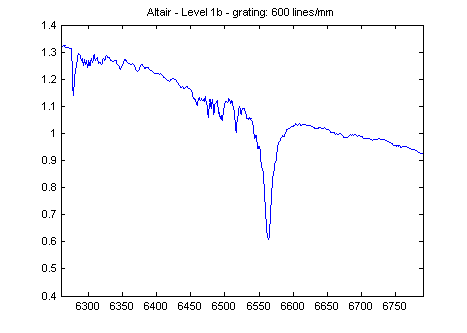
UVES spectrum of Altair :

The two spectra together (after H20 telluric lines removal on Lhires III spectrum) :

Lhires III spectrum divided by the UVES spectra:

Smoothed response curve:

We used the average of the two response curve in our further processing:

In blue, here is the 2q level Castor's spectrum (wavelength calibrated spectrum divided by the response curve) and in red the UVES spectrum of the same star:
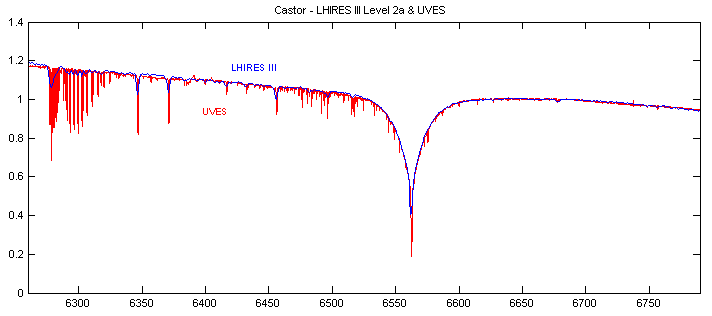
Despite the spectral resolution, they fit well together.
Same with Altair; notice the complexe continuum of this star which is visible in both spectra:

4. Results (chronological order)
Gamma Cas - 14 november 2006 - 17H57 TU - Be star - Spectral type B0IV - Magnitude V=2.5

immediate area of gamma Cas.
Takahashi FSQ106 + Digital
SLR (Canon EOS 350D).
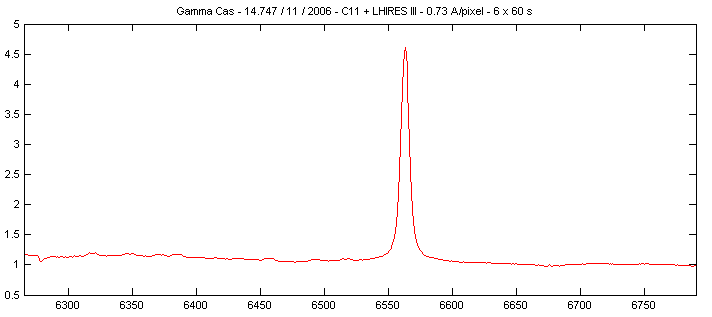

HD108 - 14 november 2006 - 18H32 TU - High luminosity supergiant star - Spectral type O6 - Magnitude V=7.4

Altair - 14 november 2006 - 18H59 TU - Spectral type A7V - Magnitude V=0.8

HD4841 - 14 november 2006 - 19H31 TU - High luminosity supergiant star - Spectral type B5 Ia - Magnitude V=6.9

AB Aur (HD31293) - 14 november 2006, 20H28 TU - Herbig Ae/Be star - Spectral type A0 - Magnitude V=7.1

AB
Aur star is the bright object
in lower left of the center.
60cm telescope
at Pic du Midi in 1994 (Buil-Thouvenot Atlas)
Object is surrounded by Vdb 31
nebulosity.
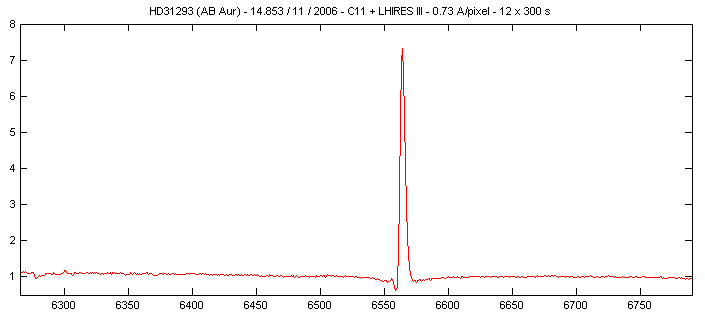

53 Cas - 14 november 2006 - 21H10 TU - High luminosity supergiant star - Spectral type B8 Ib - Magnitude V=5.6

53 Cas star (the brightest in upper right corner) near Stock 5
open cluster.
128mm refractor - Buil-Thouvenot atlas.
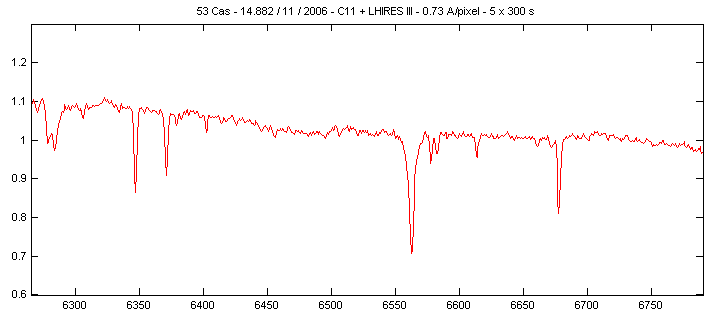
Zeta Tau - 14 november 2006 - 22H10 TU - Be star - Spectral type B2III - Magnitude V=3.0


T Tauri - 14 november 2006 - 23H00 TU - Herbig Ae/Be star - Spectral type K0IV - Magnitude V=9.9

T Tauri star centered in this
field
(60cm Pic du Midi telescope in 1995, Buil-Thouvenot Atlas).
Object
is surrounded by NGC1554 (SH2-238) nebulosity.

Beta Ori (Rigel) - 14 november 2006 - 23H53 TU - Supergiant star - Spectral type B8 Ia - Magnitude V=0.3

Zeta Ori - 15 november 2006 - 00H08 TU - Supergiant star - Spectral type O9 Ib - Magnitude V=1.8

Zeta Ori star (center) is close to the famous "horse head"
nebula.
Canon 50mm f:1.4 lens, used at f:2.8 and Digital Canon
SLR (EOS 350D).

Alpha CMi (Procyon) - 15 november 2006 - 00H26 TU - Spectral type F5IV-V - Magnitude V=0.3

Alpha Gem (Castor) - 15 november 2006 - 00H35 TU - Spectral type A2V - Magnitude V=1.6

HD50820 - 15 november 2006 - 01H10 TU - Be star - Spectral type B2IV - Magnitude V=6.2

T Tau - 15 november 2006 - 01H45 TU (second time check, short exposure)


HD250550 - 15 november 2006 - 03H32 TU - Herbig Ae/Be star - Spectral type B9 - Magnitude V=9.5

Night ends with the flat field.
5. Conclusion
Intermediate (R=2700) resolution of the Lhires III is working very well. The 600 lines/mm grating is a compromise between the required level of detail of line profile to see the chromospheric activity (monitoring of H-alpha line but potentially Helium lines too) and the limit magnitude to achieve a good signal/noise ratio.
A high sensitivity guiding camera is required. The Watec 120N camera is very efficient for exemple.
AB Aur has been recorded with a signal/ratio of 85 within pixel level (150 within a resolution element of 2.5A). P Cygni profile of Ha line is clearly visible in our spectrum and should allow to monitor this star through several nights. Short term evolution can then be recorded. Note also the small line at 6300A also visible in T Tauri spectrum. It may be the [OI] forbidden line which give the red-orange color to our polar aurora.
Observing fainter Herbig Ae/Be stars would be more difficult. Note still that T Tauri (magnitude V=9.9) shows a clear spectrum and the P Cygni profile of HD20550 (V=9.5) is also perfectly shown. Under poor seeing condition (5 to 6 arcseconds compared to 3 arcseconds for AB Aur), the recorded spectra of those two stars had a signal/noise ratio of 15 in a 1h exposure. Under better conditions, a signal/noise ratio of 20-25 should be achievable with a 28cm telescope.
Some hot supergiant stars also show nice spectra during this first run with a 600 lines/mm grating. Short and long term monitoring of such stars of several of those stars is a very interesting project to follow.